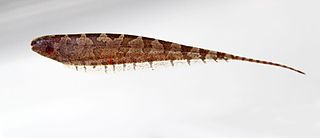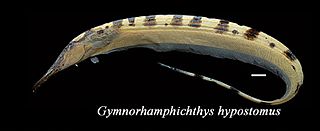
The naked-back knifefishes are a family (Gymnotidae) of knifefishes found only in fresh waters of Central America and South America. All have organs adapted to electroreception. The family has about 43 valid species in two genera. These fish are nocturnal and mostly occur in quiet waters from deep rivers to swamps. In strongly flowing waters, they may bury themselves.

The ghost knifefishes are a family, Apteronotidae, of ray-finned fishes in the order Gymnotiformes. These fish are native to Panama and South America. They inhabit a wide range of freshwater habitats, but more than half the species in the family are found deep in rivers where there is little or no light.
Gymnotus is a genus of Neotropical freshwater fish in the family Gymnotidae found widely in South America, Central America and southern Mexico. The greatest species richness is found in the Amazon basin. They are sometimes referred to by the English name banded knifefish, although this typically is reserved for the most widespread species, G. carapo. Overall Gymnotus is the most widespread genus in the order Gymnotiformes.

Sand knifefish are freshwater electric fish of the family Rhamphichthyidae, from freshwater habitats in South America.

Glass knifefishes are fishes in the family Sternopygidae in the order Gymnotiformes. Species are also known as rattail knifefishes.

The Hypopomidae are a family of fishes in the order Gymnotiformes known as the bluntnose knifefish. They may also be called grass or leaf knifefishes. These electric fish are not often eaten, of little commercial importance, rarely kept as aquarium fish, and poorly studied; however, species in this family may constitute a significant fraction of the biomass in the areas they inhabit.

The banded knifefish is a species of gymniform knifefish native to a wide range of freshwater habitats in South America. It is the most widespread species of Gymnotus, but it has frequently been confused with several relatives, including some found outside its range like the Central America G. maculosus. The English name "banded knifefish" is sometimes used for the entire genus Gymnotus instead of only the species G. carapo.

Magosternarchus is a genus of weakly electric knifefish in the family Apteronotidae, containing two species. They are endemic to Brazil, occurring in large river channels in the Amazon River basin. Both species are unusual benthic predators that specialize in biting off the tails of other knifefishes, and are characterized by their greatly enlarged jaws and teeth. Recent systematic studies indicate that both species should be included in Sternarchella instead of being placed in their own genus.

Apteronotus is a genus of weakly electric knifefish in the family Apteronotidae, distinguished by the presence of a tiny tail fin. This genus is restricted to tropical and subtropical South America and Panama where found in a wide range of freshwater habitats. They feed on small animals.
Sternarchella, the bulldog knifefish, is a genus of ghost knifefishes found at depths of 2–50 m (7–164 ft) in the main channel of large rivers in South America. Most are from the Amazon basin, but S. orthos is found both in the Amazon and Orinoco, S. orinoco is restricted to the Orinoco and S. curvioperculata restricted to the upper Paraná basin. They are often common in their habitat.
Brachyhypopomus is a genus of fish in the family Hypopomidae native primarily to tropical and subtropical South America, although a single species, B. occidentalis, also occurs in Panama and Costa Rica. They are found in a wide range of static or slow-flowing freshwater habitats such as edges of rivers, streams, floodplains and swamps, but they are absent from deep river channels. There are both species in well-oxygenated waters and poorly oxygenated waters; those in the latter have adaptions that allow them to survive this like larger gills or the capability of gulping up mouthfuls of air from the water surface. Brachyhypopomus feed during the night on small invertebrates.
Hypopygus is a genus of South American gymnotiform knifefishes native to the Amazon, Orinoco and upper Paraguay basins, as well as rivers in the Guianas. They are often common, and found near submerged roots, aquatic vegetation and leaf-litter in streams, edges of rivers and floodplains. They are regularly found among vegetation in floating meadows, a habitat that often contains little oxygen, but they are well-adapted to this.
Microsternarchus is a genus of bluntnose knifefish that is found in creeks and streams, often in areas with submerged vegetation, roots and leaf litter, in the Amazon, Orinoco, Essequibo–Rupununi and Río de la Plata basins in South America. The two recognized species are both small knifefish, with the largest being M. bilineatus at up to 12 cm (4.7 in) in total length. The other is M. brevis, which at up to only 5.3 cm (2.1 in) is the world's smallest knifefish. Microsternarchus are very similar to Brachyhypopomus.

Gymnorhamphichthys is a genus of South American sand knifefishes found in the Amazon, Araguaia, Orinoco and Río de la Plata basins, as well as rivers in the Guianas. They inhabit both small streams and large rivers, but usually over a sandy bottom. During the night they swim head-down over the sandy bottom to locate small invertebrate prey like insect larvae and during the day they rest buried under the sand.

Eigenmannia is a genus of fish in the family Sternopygidae native to tropical and subtropical South America, and Panama. They are typically found in slow-flowing streams, along the edge of large rivers, in deep river channels and in floodplains, and the genus also includes E. vicentespelaea, the only cave-adapted knifefish. Eigenmannia are often found near submerged roots, aquatic plants and floating meadows.
Rhabdolichops is a genus of glass knifefishes found in Amazon, Orinoco and Maroni basins in tropical South America. They live near the bottom in main river channels, floodplains and lagoons, and are typically found in relatively deep waters.

Sternopygus is a genus of glass knifefishes found in tropical and subtropical South America, and Panama. They inhabit a wide range of freshwater habitats, from fast-flowing rivers to essentially static waters in floodplains, and shallow habitats to the bottom of deep rivers. S. macrurus will even visit brackish mangrove to feed.

Hydrolycus armatus is a species of dogtooth characin found in freshwater of tropical South America. It is sometimes known as the payara, a name it shares with the related H. scomberoides.

Steatogenys elegans, the barred knifefish, is a species of Hypopomidae found in tropical South America. It is the type species of its genus. It is an electric fish found in a wide range of freshwater habitats in the Amazon, Orinoco and Essequibo river basins. It reaches almost 30 cm (1 ft) in total length.
The Purus Arch is a basement high in Brazil that makes up the modern western boundary of the Amazon sedimentary basin. The Purus Arch is thought to be a former graben of Middle Proterozoic age that was inversed in the Late Proterozoic.











